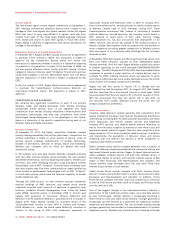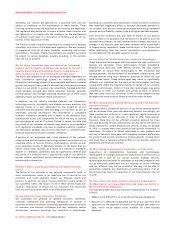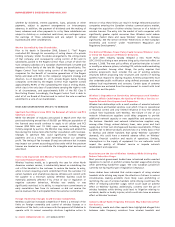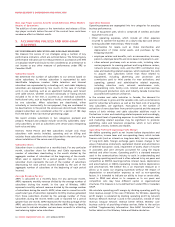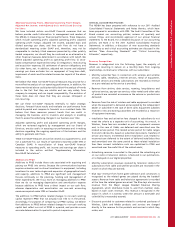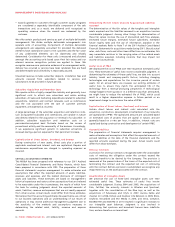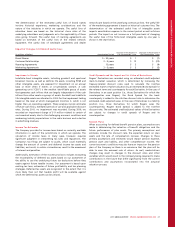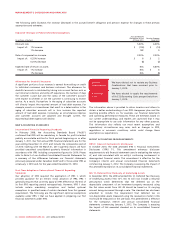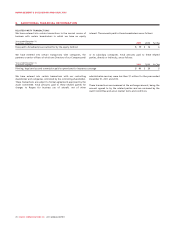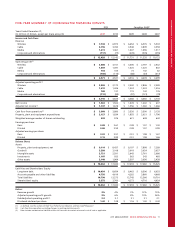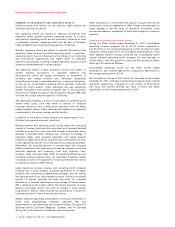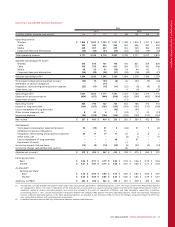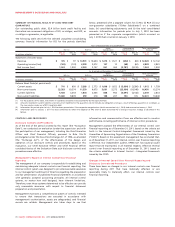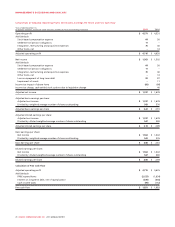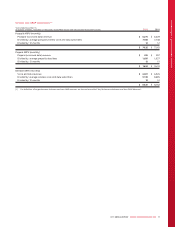Rogers 2011 Annual Report Download - page 72
Download and view the complete annual report
Please find page 72 of the 2011 Rogers annual report below. You can navigate through the pages in the report by either clicking on the pages listed below, or by using the keyword search tool below to find specific information within the annual report.
MANAGEMENT’S DISCUSSION AND ANALYSIS
The following table illustrates the increase (decrease) in the accrued benefit obligation and pension expense for changes in these primary
assumptions and estimates:
Impact of Changes in Pension-Related Assumptions
(In millions of dollars)
Accrued Benefit
Obligation at End
of Fiscal 2011 Pension Expense
Fiscal 2011
Discount rate 5.50% 6.00%
Impact of: 1% increase $ (150) $ (10)
1% decrease 182 9
Rate of compensation increase 3.00% 3.00%
Impact of: 0.25% increase $8$2
0.25% decrease (8) (2)
Expected rate of return on assets N/A 6.80%
Impact of: 1% increase N/A $ 6
1% decrease N/A (6)
Allowance for Doubtful Accounts
A significant portion of our revenue is earned from selling on credit
to individual consumers and business customers. The allowance for
doubtful accounts is calculated by taking into account factors such as
our historical collection and write-off experience, the number of days
the customer is past due and the status of the customer’s account
with respect to whether or not the customer is continuing to receive
service. As a result, fluctuations in the aging of subscriber accounts
will directly impact the reported amount of bad debt expense. For
example, events or circumstances that result in a deterioration in the
aging of subscriber accounts will in turn increase the reported
amount of bad debt expense. Conversely, as circumstances improve
and customer accounts are adjusted and brought current, the
reported bad debt expense will decline.
NEW ACCOUNTING STANDARDS
International Financial Reporting Standards
In February 2008, the Accounting Standards Board (“AcSB”)
confirmed that IFRS will be mandatory in Canada for profit-oriented
publicly accountable entities for fiscal periods beginning on or after
January 1, 2011. Our first annual IFRS financial statements are for the
year ending December 31, 2011 and include the comparative period
of 2010. Starting with the March 31, 2011 quarterly report, we have
provided unaudited consolidated quarterly financial information in
accordance with IFRS including comparative figures for 2010. Please
refer to Note 3 of our Audited Consolidated Financial Statements for
a summary of the differences between our financial statements
previously prepared under Canadian GAAP and to those under IFRS as
at January 1, 2010 and, for the year ended December 31, 2010.
First-Time Adoption of International Financial Reporting
Standards
Our adoption of IFRS required the application of IFRS 1, which
provides guidance for an entity’s initial adoption of IFRS. IFRS 1
generally requires that an entity apply all IFRS effective at the end of
its first IFRS reporting period retrospectively. However, IFRS 1 does
include certain mandatory exceptions and limited optional
exemptions in specified areas of certain standards from this general
requirement. The following are the significant optional exemptions
available under IFRS 1 that we have applied in preparing our first
financial statements under IFRS.
Business
Combinations
We have elected not to restate any Business
Combinations that have occurred prior to
January 1, 2010.
Borrowing
Costs
We have elected to apply the requirements
of IAS 23 Borrowing Costs prospectively from
January 1, 2010.
The information above is provided to allow investors and others to
obtain a better understanding of our IFRS changeover plan and the
resulting possible effects on, for example, our financial statements
and operating performance measures. These are estimates based on
our current understandings, and readers are cautioned that it may
not be appropriate to use such information for any other purpose.
This information also reflects our most recent assumptions and
expectations; circumstances may arise, such as changes in IFRS,
regulations or economic conditions, which could change these
assumptions or expectations.
RECENT ACCOUNTING PRONOUNCEMENTS
IFRS 7, Financial Instruments: Disclosures
In October 2010, the IASB amended IFRS 7, Financial Instruments:
Disclosures (“IFRS 7”). This amendment enhances disclosure
requirements to aid financial statement users in evaluating the nature
of, and risks associated with an entity’s continuing involvement in
derecognized financial assets. This amendment is effective for the
Company’s interim and annual consolidated financial statements
commencing January 1, 2012. The Company is assessing the impact of
this amended standard on its consolidated financial statements.
IAS 12, Deferred Tax: Recovery of Underlying Assets
In December 2010, the IASB amended IAS 12, Deferred Tax: Recovery
of Underlying Assets (“IAS 12”). IAS 12 will now include a rebuttal
presumption which determines that the deferred tax on the
depreciable component of an investment property measured using
the fair value model from IAS 40 should be based on its carrying
amount being recovered through a sale. The standard has also been
amended to include the requirement that deferred tax on
non-depreciable assets measured using the revaluation model in IAS
16 should be measured on the sale basis. This amendment is effective
for the Company’s interim and annual consolidated financial
statements commencing January 1, 2012. The Company is assessing
the impact of this amended standard on its consolidated financial
statements.
68 ROGERS COMMUNICATIONS INC. 2011 ANNUAL REPORT


